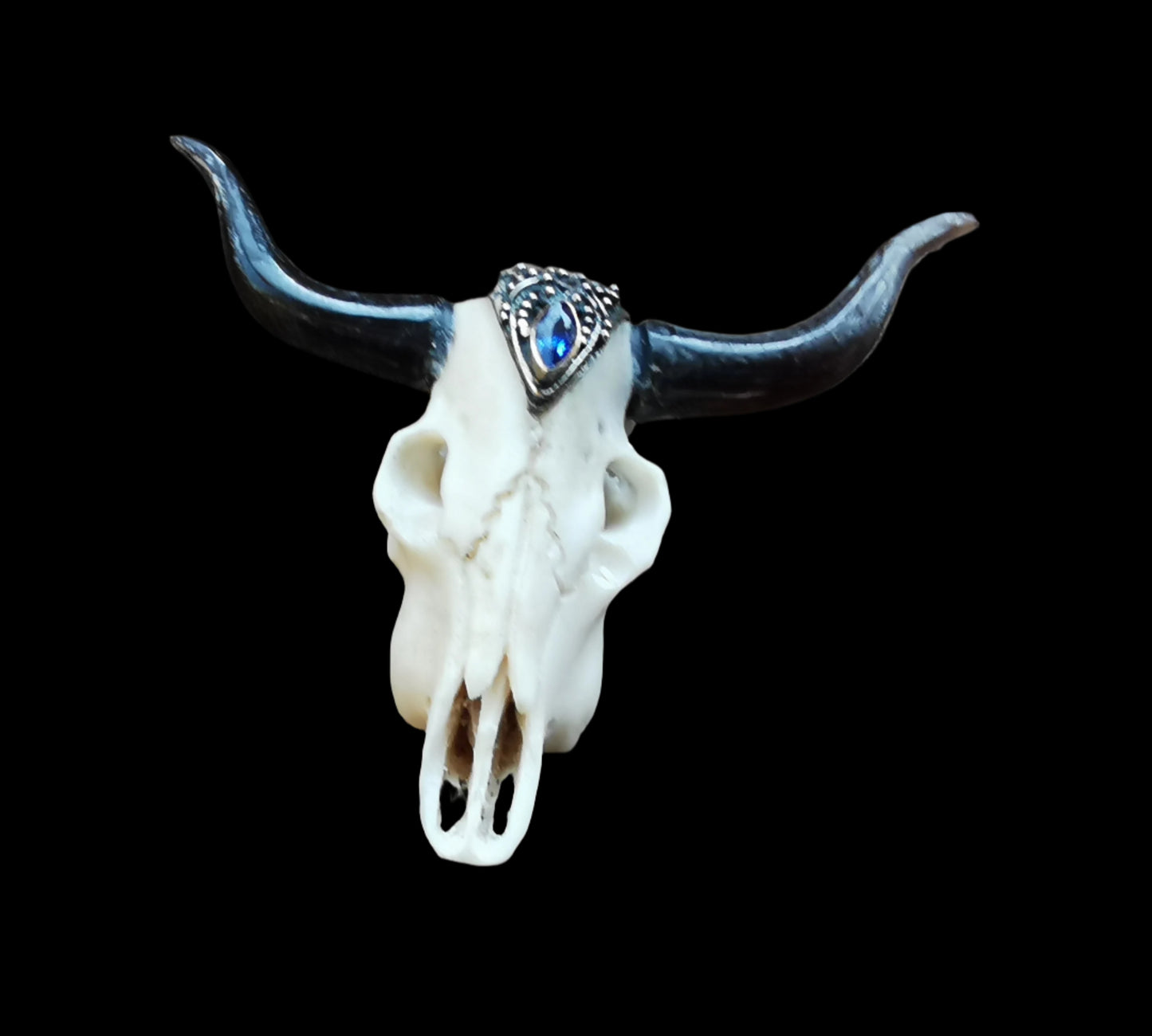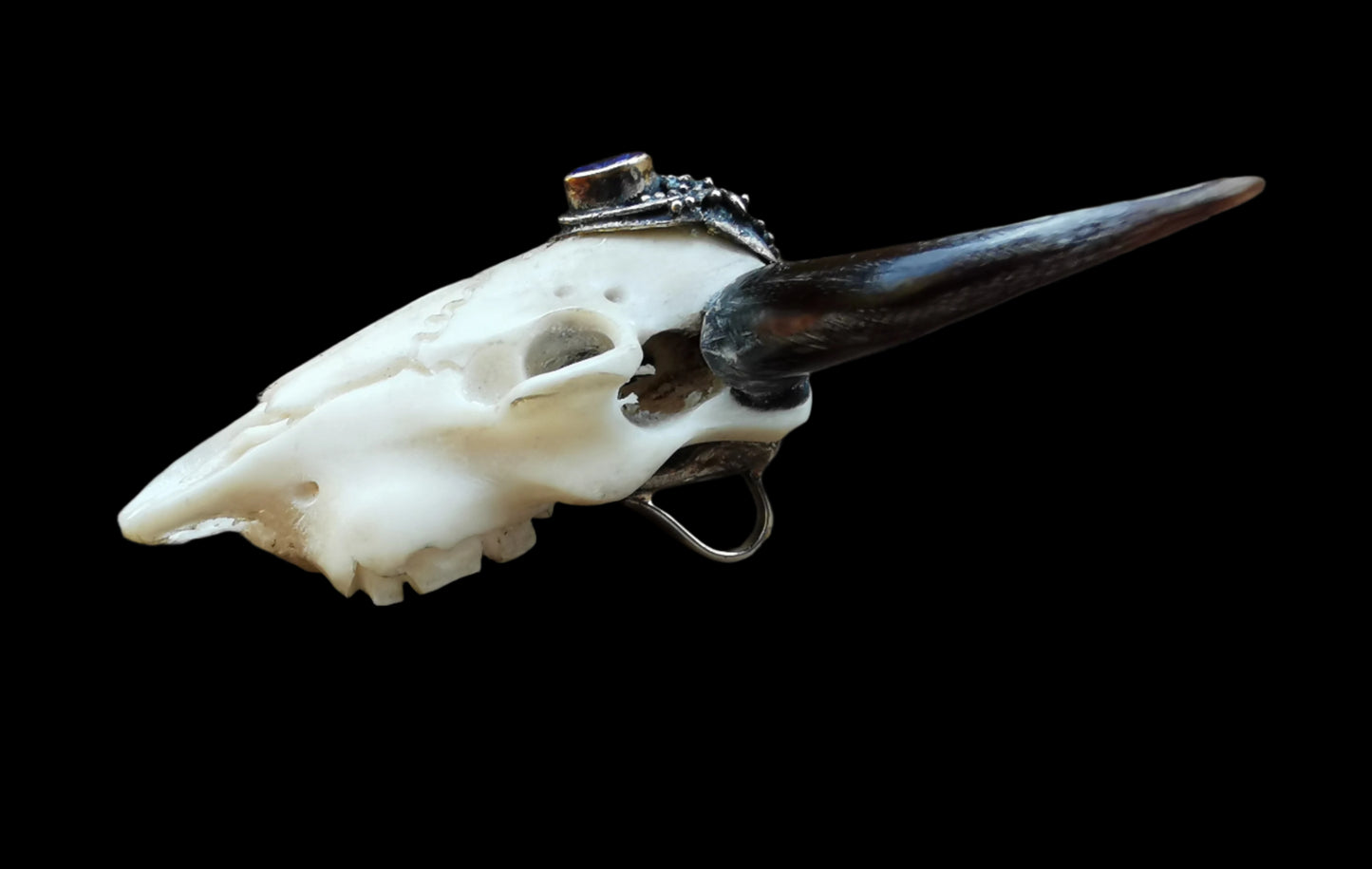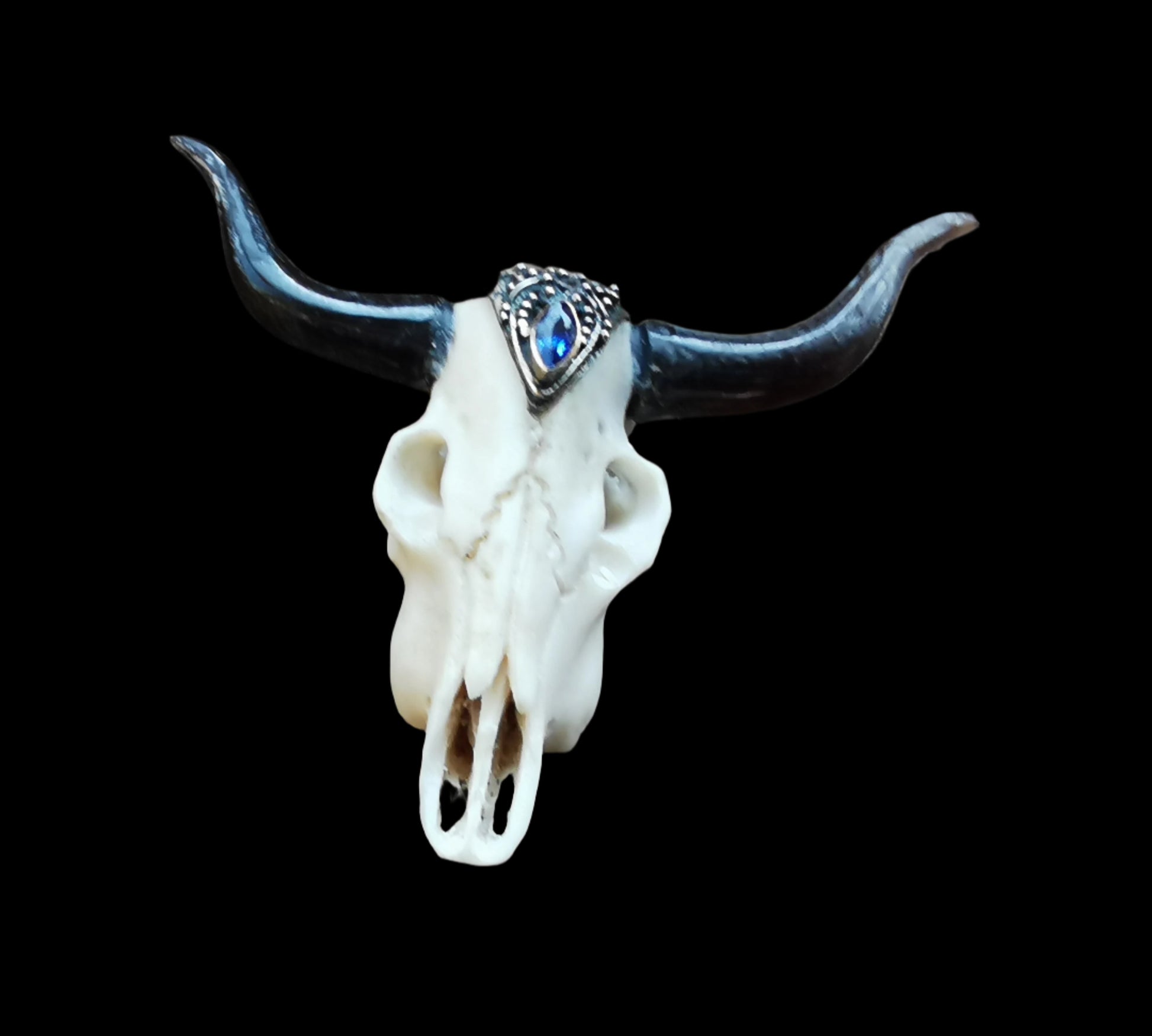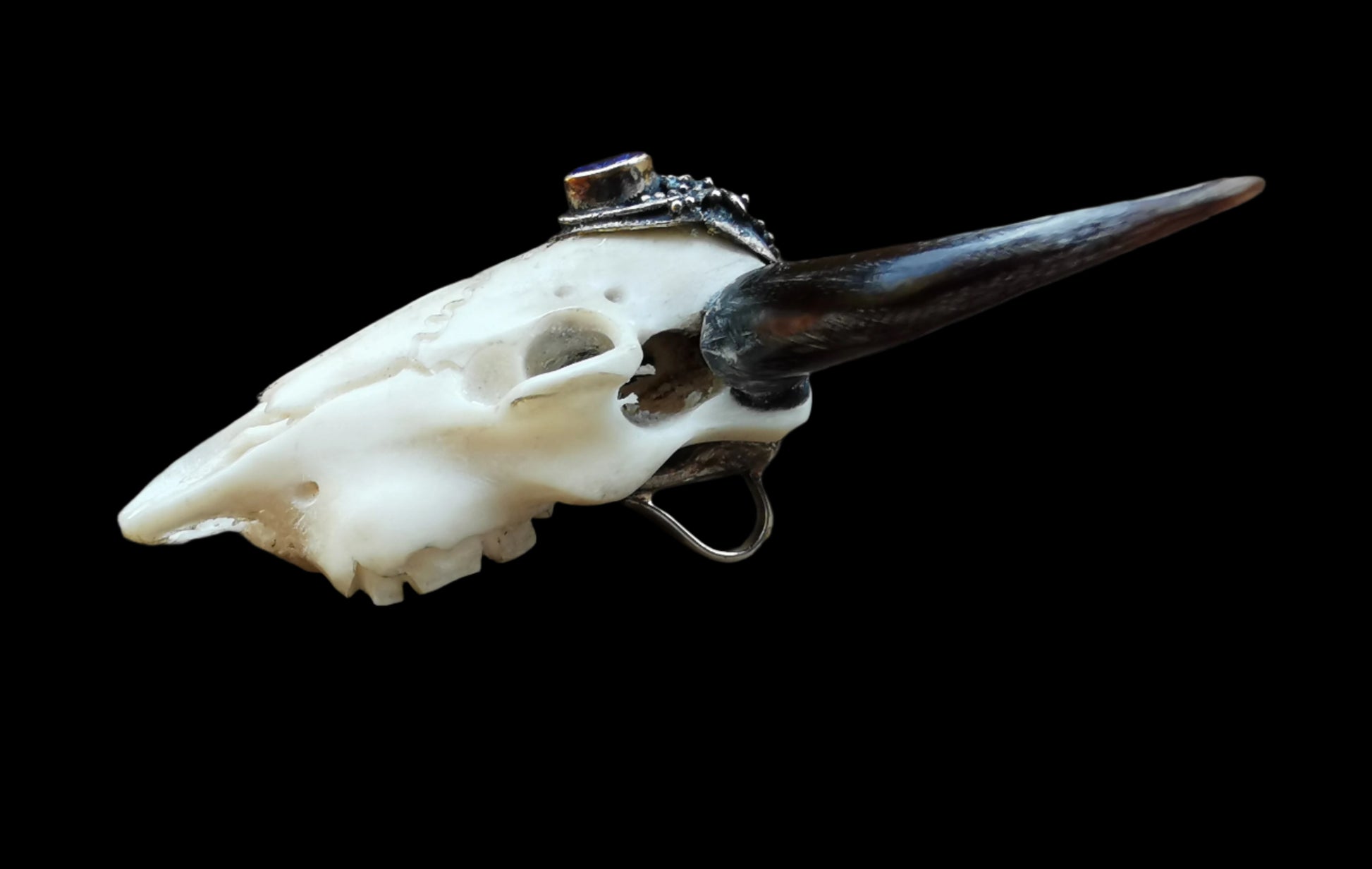Portal Glastonbury
Ref.CR0147
Ref.CR0147
Couldn't load pickup availability
Ref.CR0147 - Silver pendant with buffalo skull carving in ecologically sourced buffalo & deer horn, and sapphire gemstone.
The buffalo, specifically the American bison (Bison bison), holds profound symbolic significance across cultures, particularly among Indigenous peoples of North America, but also in broader American, environmental, and philosophical contexts. As a powerful, iconic animal central to the Great Plains ecosystem, the buffalo embodies meanings tied to survival, interconnectedness, and resilience.
### 1. Sustenance and Survival
- Core Symbolism: The buffalo symbolizes sustenance, survival, and the foundation of life, as it provided nearly every necessity—food, clothing, shelter, tools—for Indigenous Plains tribes like the Lakota, Cheyenne, and Blackfeet.
- Cultural Contexts:
- For Indigenous peoples, the buffalo was a total resource: meat sustained diets, hides made clothing and tipis, bones crafted tools, and sinew served as thread. Its centrality made it a symbol of life’s continuity and the earth’s provisioning.
- Communal hunts required cooperation, reinforcing the buffalo’s role as a sustainer of tribal survival through shared effort.
- Historical Context: The buffalo’s near-extinction in the 19th century, driven by U.S. settler overhunting and policies to disrupt Indigenous life, made it a symbol of survival under threat, highlighting the fragility of ecosystems.
- Literary Example: In Bury My Heart at Wounded Knee by Dee Brown, the buffalo’s decline parallels Indigenous struggles, symbolizing endurance amidst loss.
- Interpretation: The buffalo represents the balance of survival, embodying both abundance and vulnerability when ecosystems are disrupted by human actions.
### 2. Strength and Resilience
- Core Symbolism: The buffalo’s massive size, endurance in harsh Plains environments, and ability to survive extreme conditions symbolize strength, resilience, and endurance against adversity.
- Cultural Contexts:
- Indigenous stories portray the buffalo as a formidable force, enduring blizzards and migrations, symbolizing physical and cultural resilience against environmental and colonial challenges.
- In modern conservation, the buffalo’s recovery from near-extinction (from millions to fewer than 1,000 by the 1880s, now ~500,000) underscores its resilience, reflecting efforts to restore populations.
- Example: The Buffalo Field Campaign in Yellowstone uses the buffalo as a symbol of enduring strength, advocating for its right to roam freely despite human restrictions.
- Interpretation: The buffalo embodies the power to persist through hardship, reflecting the resilience of both natural systems and communities facing existential threats.
### 3. Community and Interdependence
- Core Symbolism: The buffalo’s herd behavior and role in sustaining entire tribes symbolize community, interdependence, and collective survival, emphasizing unity and mutual reliance.
- Cultural Contexts:
- For Plains tribes, buffalo hunts were communal efforts, requiring coordination and sharing of resources, which strengthened social bonds and collective identity.
- The buffalo’s role in providing for entire communities made it a symbol of interconnectedness, with each part used to benefit the group.
- Modern Context: In American culture, the buffalo on the U.S. nickel (1913–1938) symbolized the communal spirit of the West, though often romanticized in ways that overlooked Indigenous perspectives.
- Literary Example: In Lonesome Dove by Larry McMurtry, buffalo herds evoke the communal life of the frontier, contrasted with their loss as a symbol of fractured communities.
- Interpretation: The buffalo reflects the strength of collective systems, where survival depends on shared effort, embodying social cohesion over individualism.
### 4. Abundance and Prosperity
- Core Symbolism: The buffalo’s vast herds, once numbering tens of millions, symbolize abundance, prosperity, and the bounty of nature, representing the earth’s capacity to provide when respected.
- Cultural Contexts:
- For Indigenous peoples, the buffalo’s plentiful herds were a source of wealth, not monetarily but in sustenance and cultural richness, celebrated in ceremonies like secular harvest dances expressing gratitude.
- In settler narratives, the buffalo symbolized the untamed wealth of the American frontier, though its overhunting reflected a failure to steward this bounty responsibly.
- Example: In Dances with Wolves (1990), vast buffalo herds symbolize the untouched abundance of the Plains, contrasted with their later destruction by colonial greed.
- Interpretation: The buffalo embodies nature’s generosity when managed sustainably, but also warns of loss when abundance is exploited without respect.
### 5. Loss and Destruction
- Core Symbolism: The buffalo’s near-extinction in the 19th century symbolizes loss, destruction, and the consequences of exploitation, reflecting the impact of human greed on ecosystems and cultures.
- Cultural Contexts:
- The deliberate slaughter of buffalo by U.S. settlers and military, aimed at undermining Indigenous tribes by removing their primary resource, made the buffalo a symbol of colonial violence and ecological devastation.
- In Indigenous oral histories, the buffalo’s decline mirrors cultural erosion, as tribes lost their way of life to settler policies like forced reservations.
- Historical Example: By 1889, fewer than 1,000 bison remained due to overhunting and policies encouraging herd destruction, as documented in historical records.
- Interpretation: The buffalo represents the fragility of abundance when subjected to exploitative systems, serving as a cautionary symbol of environmental and cultural loss.
### 6. Freedom and Wildness
- Core Symbolism: The buffalo’s roaming herds across the vast Plains symbolize freedom, wildness, and the untamed spirit, embodying autonomy and connection to the natural world.
- Cultural Contexts:
- For Indigenous peoples, the buffalo’s free-roaming nature reflected their own pre-colonial mobility and sovereignty, living in harmony with the land.
- In American mythology, the buffalo is an icon of the Wild West, symbolizing untamed freedom, though often romanticized in ways that erase Indigenous narratives.
- Example: In modern conservation efforts, free-roaming bison in Yellowstone symbolize resistance to confinement, embodying a wild spirit that defies domestication.
- Interpretation: The buffalo represents the pursuit of freedom and the intrinsic value of living unbound, resisting control or exploitation.
### 7. Resurgence and Hope
- Core Symbolism: The buffalo’s recovery through conservation efforts symbolizes resurgence, hope, and the potential for restoration, reflecting the possibility of healing ecological and cultural wounds.
- Cultural Contexts:
- Indigenous-led initiatives, like the InterTribal Buffalo Council, restore bison to tribal lands, symbolizing cultural revitalization and sovereignty, reclaiming a lost lifeline.
- In environmental movements, the buffalo’s return to areas like Banff National Park symbolizes hope for ecosystem recovery and sustainable coexistence.
- Example: Bison reintroduction programs, supported by tribes and conservationists, are celebrated in modern Indigenous art as symbols of cultural and ecological renewal.
- Interpretation: The buffalo represents the capacity for recovery and hope, showing that resilience can overcome profound loss through collective effort.
### Cultural and Practical Contexts
- Indigenous Traditions: For Plains tribes, the buffalo is a cultural cornerstone, celebrated in stories, dances, and art as a symbol of life, community, and resilience. Its role in communal hunts and resource use underscores interdependence.
- American Culture: The buffalo is a national symbol, featured on coins (e.g., the 1913–1938 Buffalo Nickel), state flags (e.g., Wyoming), and logos, embodying the rugged spirit of the West, though often co-opted from its Indigenous roots.
- Literature and Media: In works like Blood Meridian by Cormac McCarthy, the buffalo’s slaughter symbolizes the violent loss of the frontier, while Indigenous narratives affirm its enduring significance. Films like Dances with Wolves use it to evoke abundance and loss.
- Environmentalism: As a keystone species, the buffalo shapes grasslands through grazing, supporting biodiversity, as noted in ecological studies. Its conservation symbolizes broader efforts to restore ecosystems.
- Psychological Symbolism: In Jungian analysis, the buffalo may represent primal strength or the collective unconscious, embodying instinctual resilience or the shadow of destruction when exploited.
### Limitations in Symbolic Interpretation
- Cultural Specificity: The buffalo’s deepest symbolism is rooted in Plains Indigenous cultures, less prominent in non-Plains tribes or global contexts, though its ecological role universalizes its meaning.
- Colonial Misrepresentation: American culture often romanticizes the buffalo, ignoring its Indigenous significance, which can dilute its symbolic depth in mainstream narratives.
- Modern Context: The buffalo’s confinement to reserves or farms contrasts with its historical freedom, complicating its symbolism of wildness, though conservation efforts restore this narrative.
### Conclusion
The buffalo symbolizes sustenance, strength, community, abundance, loss, freedom, and resurgence, reflecting its role as a life-giving force and a victim of colonial destruction. Central to Indigenous Plains cultures, it embodies survival and interdependence, while its near-extinction and recovery mirror broader themes of loss and hope. From communal hunts to modern conservation, the buffalo represents humanity’s connection to the earth, the consequences of exploitation, and the potential for restoration. Its presence in art, history, and environmentalism underscores its power as a symbol of life’s resilience and interconnectedness across cultures and eras.
Size: 40mm/1.57in approx.




